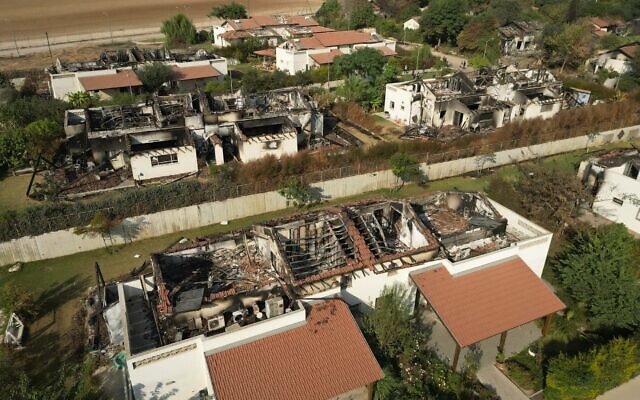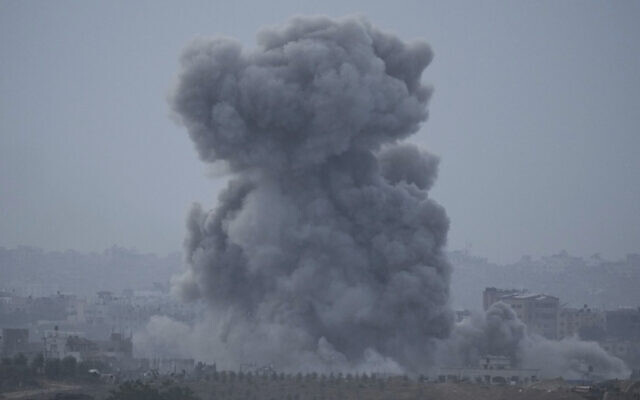Hamas Sought to Reach West Bank with Oct. 7 Onslaught, Spark Wider War
Washington Post says terrorists sought to attack cities, military bases in planned deeper incursion; terror group gathered intelligence from laborers who worked in Israel.

The Hamas terror group had ambitious plans beyond what it was able to carry out during its devastating Oct. 7 onslaught, including possibly reaching the West Bank and larger Israeli cities in order to spark a broader war, according to a Sunday report.
Reconnaissance information and maps suggesting the West Bank was a target for the brutal incursion were discovered in the possession of one of the assault units that burst across the border, The Washington Post reported, citing two senior Middle Eastern intelligence officials and a former U.S. official with detailed knowledge of the evidence.
Furthermore, officials said terrorists were found with supplies to last several days, indicating plans of a deeper incursion.
“They planned a second phase, including in major Israeli cities and military bases,” an unnamed senior Israeli official said.
“If that had occurred, it would have been a huge propaganda win — a symbolic blow not only against Israel but also against the Palestinian Authority,” the U.S. official said, referencing the government that administers parts of the West Bank.
Hamas overthrew the PA, which is controlled by the rival Fatah group, in Gaza in 2007 in a violent coup and has ruled there ever since.
Terrorists burst through the border and rampaged through southern communities on Oct. 7, brutally murdering some 1,200 people, mostly civilians in their homes and at a music festival, and abducting at least 240 people into the Gaza Strip under a deluge of rocket fire aimed all over Israel.
Since the massacre, there has been a noted uptick in terror attacks or attempted terror attacks by Palestinians against Israelis in the West Bank and East Jerusalem, and clashes with the Hezbollah terror group and Palestinian terror groups on the border with Lebanon.
At the same time, the PA health ministry has said that more than 176 West Bank Palestinians have been killed by Israeli forces and in some cases, by settlers. The Yesh Din rights group said earlier this month that there had been over 172 incidents of settler violence and harassment against Palestinians in at least 84 Palestinian towns and communities.

As part of its intelligence-gathering effort before Oct. 7, Hamas compiled information from Gazan day laborers who were allowed to enter Israel every day to work, various intelligence officials from multiple countries told The Post.
Many of the laborers worked in the communities that were ravaged by Hamas, where entire families were shot, burned alive, and mutilated in their homes.
Hamas also deployed cheap drones to map southern communities and monitored websites in order to study life in kibbutzim and the layout of homes.
Ali Soufan, a former FBI counterterrorism official, told The Post that Hamas’s intelligence gathering was not incredibly sophisticated but was well-thought-out.
“If you’re in prison, you study the prison security system. That is what Hamas has been doing for 16 years,” he said. “Their on-the-ground intelligence was way better than anything the Iranians could have given them.”
The report also detailed the terror group’s deception of Israel, which it carried out by making it appear it was becoming more pragmatic and valued the welfare of the enclave it ruled.
Hamas appeared to abide by a ceasefire with Israel following a bout of fighting in May 2021 and stayed out of subsequent Israeli clashes with the Palestinian Islamic Jihad terror group.
“Hamas wants no more wars” was a welcome message, Michael Milshtein, the former chief of Palestinian affairs in the IDF’s Military Intelligence, told The Post.

In exchange, Israel increased work permits to up to 20,000 while allowing millions in Qatari development aid to flow into the Strip, former Military Intelligence head Amos Yadlin said.
Meanwhile, Israel was distracted by what was mistakenly viewed as a more prominent threat: a terror wave that claimed dozens of Israeli lives and clashes with Palestinians in the West Bank.
Over the past year, Jordan intercepted several weapons shipments en route to the West Bank, two Middle Eastern intelligence officials with knowledge of the incidents were cited as saying.
The report said the shipments included assault rifles, pistols, silencers, Claymore-style antipersonnel mines, and C-4 military explosives, which were smuggled by trucks and drones — some of which were equipped with anti-jamming devices that made them difficult to bring down, according to one of the officials.
Analysts told the paper they were likely moved into Jordan from Syria and Iraq by Iranian proxy militias.
“This was not one network but multiple networks,” the official said. “Many of the attempts were foiled, and people were arrested. It was clear they were trying to use the same routes and methods as drug traffickers.”
Meanwhile, Israel “allowed a Palestinian army to be built by Hamas and kept telling itself that Hamas could be deterred,” said Yadlin, adding that Israel “had been deceived.”

In response to the massacre, Israel launched an intense aerial and ground offensive vowing to destroy Hamas. The offensive has killed over 11,000 people, according to the Hamas-run health ministry in Gaza. The figure cannot be verified independently and is believed to include terror operatives and civilians killed by misfired Palestinian rockets.
According to current and former intelligence and counterterror experts, Hamas expected the Israeli response and was willing to make the sacrifice in order to sabotage efforts at normalization between Israel and the Arab world, such as with Saudi Arabia.
“They were very clear-eyed as to what would happen to Gaza on the day after,” a senior Israeli military official involved in investigations of the Oct. 7 massacre said. “They wanted to buy their place in history — a place in the history of jihad — at the expense of the lives of many people in Gaza.”
Hamas official Ghazi Hamad stressed in an interview in October that the group was ready to “pay a price” for its actions, telling Lebanon’s LCBI network: “We are called a nation of martyrs, and we are proud to sacrifice martyrs.”



comments